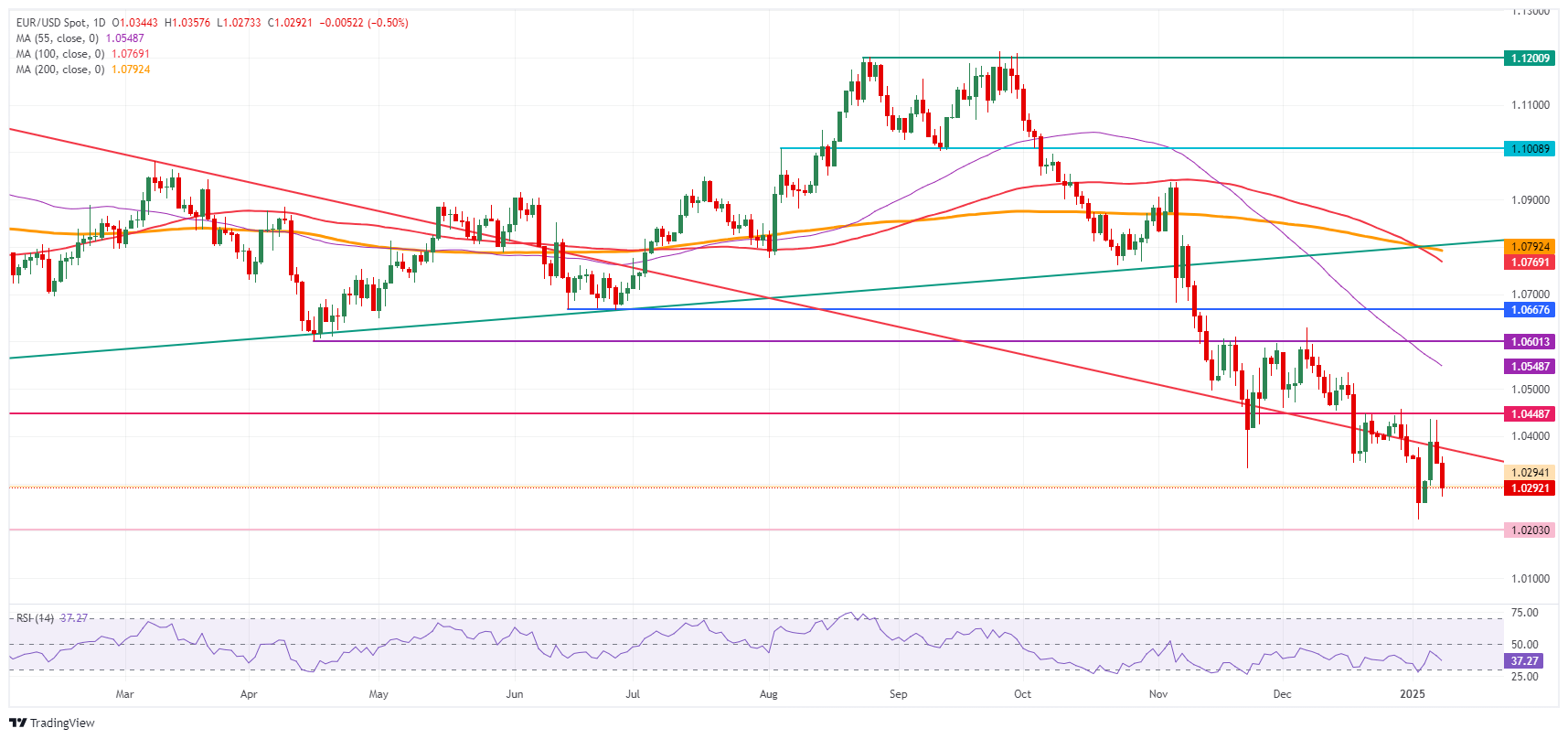EUR/USD sinks on the back of poor German and Eurozone data

- EUR/USD sells off on Wednesday after being rejected above 1.0400 this week.
- Earlier this Wednesday German factory orders sank lower while Eurozone sentiment numbers shrunk further.
- President-elect Donald Trump ramped up geopolitical rhetoric on the global stage during a press conference.
The EUR/USD pair is free falling and snaps 1.0300 to the downside at the time of writing on Wednesday after being rejected above 1.0400 earlier in the week. The pair erases most of the initial weekly gains after German factory orders data for November came out. The heavily industrialized core European country saw Factory Orders shrink by 5.4% in November, compared to a 1.5% decline in October. The data could not have come at a worse time, given the political campaigning ahead of the German snap elections on February 23.
Meanwhile, markets are on edge over President-elect Donald Trump, who is further shaking up the geopolitical scene. In a statement held at Mar-a-Lago on Tuesday, Trump reiterated his desire to incorporate Greenland, the Panama Canal, and Canada into the United States. Trump also mentioned again that he will address the US rates, which are too high at the moment and need to come down substantially, Bloomberg reports.
Daily digest market movers: Germany stalls
- German Factory Orders sank in November, contracting by 5.4% on the month compared to the 0% expected. On a yearly basis, factory orders fell by 1.7%, compared to the rise of 5.7% last seen in October.
- German Retail Sales decreased by 0.6% in November, missing the positive 0.5% expectation. At least the actual number is better than the -1.5% seen in October.
- December’s French Consumer Confidence came in at 89, a touch lower than the 90 from November.
- Eurozone Consumer Confidence for December remains unchanged at -14.5, while Industrial Confidence misses its estimate and falls to -14.1, lower than the -11.7 expected and below the revised -11.4 from November.
- November Producer Price Index data for the Eurozone sees a 1.6% uptick against the previous 0.4% increase, and beating the 1.5% consensus view.
- German Bunds ticked up further to hit a near-fresh six-month high of 2.517%, which is no longer far off from the 2.642% high seen in July last year.
- European equities are mildly positive, beating the negative tone seen in Asia, where equities across the region are set to close in red numbers on Wednesday.
Technical Analysis: Heading in the wrong direction for all the right reasons
The EUR/USD revival at the beginning of this week looks dead and buried. With a firm correction during the US trading session on Tuesday, it looks like US Dollar (USD) bulls are dominating again. With the resurgence to 1.0440, a window of opportunity was offered for US Dollar bulls that had missed the earlier entry at the end of December.
For the EUR/USD recovery to continue, the first big level to break is 1.0448, the low of October 3, 2023. Once through that level, the 55-day Simple Moving Average (SMA) at 1.0549 comes into play. Another catalyst will be needed for this kind of move, as it could squeeze the Dollar bulls.
On the downside, ahead of the current two-year low of 1.0224, the 1.0294 level is now acting as the new first line of defence. It was a pivotal point on Monday, offering room for buyers in EUR/USD to get involved and push price action higher. Further down, the round level at 1.02 would mean a fresh two-year low. Breaking below that level would open up the room to head to parity, with 1.0100 as the last man standing before that magical 1.00 level.
EUR/USD: Daily Chart
Banking crisis FAQs
The Banking Crisis of March 2023 occurred when three US-based banks with heavy exposure to the tech-sector and crypto suffered a spike in withdrawals that revealed severe weaknesses in their balance sheets, resulting in their insolvency. The most high profile of the banks was California-based Silicon Valley Bank (SVB) which experienced a surge in withdrawal requests due to a combination of customers fearing fallout from the FTX debacle, and substantially higher returns being offered elsewhere.
In order to fulfill the redemptions, Silicon Valley Bank had to sell its holdings of predominantly US Treasury bonds. Due to the rise in interest rates caused by the Federal Reserve’s rapid tightening measures, however, Treasury bonds had substantially fallen in value. The news that SVB had taken a $1.8B loss from the sale of its bonds triggered a panic and precipitated a full scale run on the bank that ended with the Federal Deposit Insurance Corporation (FDIC) having to take it over.The crisis spread to San-Francisco-based First Republic which ended up being rescued by a coordinated effort from a group of large US banks. On March 19, Credit Suisse in Switzerland fell foul after several years of poor performance and had to be taken over by UBS.
The Banking Crisis was negative for the US Dollar (USD) because it changed expectations about the future course of interest rates. Prior to the crisis investors had expected the Federal Reserve (Fed) to continue raising interest rates to combat persistently high inflation, however, once it became clear how much stress this was placing on the banking sector by devaluing bank holdings of US Treasury bonds, the expectation was the Fed would pause or even reverse its policy trajectory. Since higher interest rates are positive for the US Dollar, it fell as it discounted the possibility of a policy pivot.
The Banking Crisis was a bullish event for Gold. Firstly it benefited from demand due to its status as a safe-haven asset. Secondly, it led to investors expecting the Federal Reserve (Fed) to pause its aggressive rate-hiking policy, out of fear of the impact on the financial stability of the banking system – lower interest rate expectations reduced the opportunity cost of holding Gold. Thirdly, Gold, which is priced in US Dollars (XAU/USD), rose in value because the US Dollar weakened.
Information on these pages contains forward-looking statements that involve risks and uncertainties. Markets and instruments profiled on this page are for informational purposes only and should not in any way come across as a recommendation to buy or sell in these assets. You should do your own thorough research before making any investment decisions. FXStreet does not in any way guarantee that this information is free from mistakes, errors, or material misstatements. It also does not guarantee that this information is of a timely nature. Investing in Open Markets involves a great deal of risk, including the loss of all or a portion of your investment, as well as emotional distress. All risks, losses and costs associated with investing, including total loss of principal, are your responsibility. The views and opinions expressed in this article are those of the authors and do not necessarily reflect the official policy or position of FXStreet nor its advertisers. The author will not be held responsible for information that is found at the end of links posted on this page.
If not otherwise explicitly mentioned in the body of the article, at the time of writing, the author has no position in any stock mentioned in this article and no business relationship with any company mentioned. The author has not received compensation for writing this article, other than from FXStreet.
FXStreet and the author do not provide personalized recommendations. The author makes no representations as to the accuracy, completeness, or suitability of this information. FXStreet and the author will not be liable for any errors, omissions or any losses, injuries or damages arising from this information and its display or use. Errors and omissions excepted.
The author and FXStreet are not registered investment advisors and nothing in this article is intended to be investment advice.


![These hidden stocks are flashing buy zones amid market correction [Video]](https://connecticutnewspress.com/wp-content/uploads/2025/01/31108-these-hidden-stocks-are-flashing-buy-zones-amid-market-correction-video-390x220.jpg)


